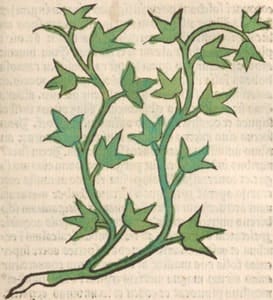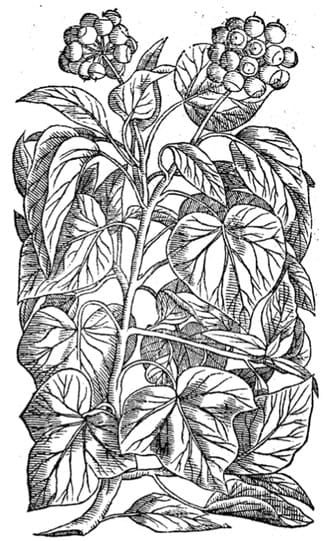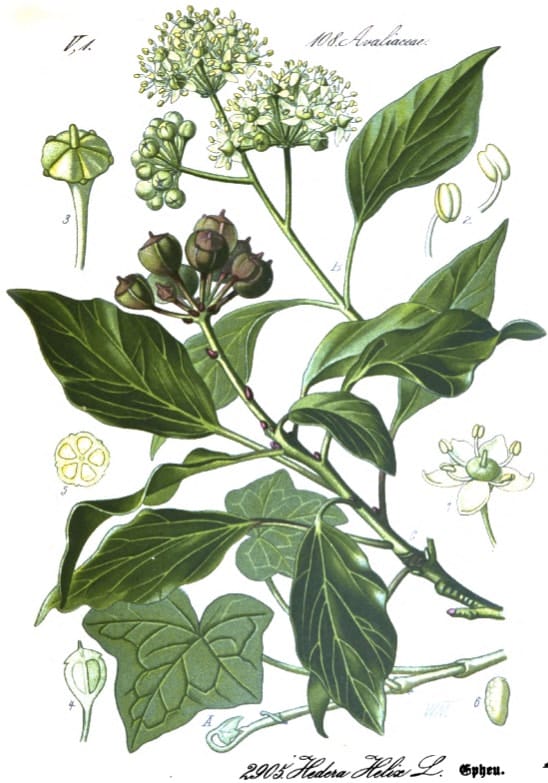Hedera, IvyHedera arborea (“Tree Ivy”) |

|

|
 Herbarius latinus, Petri, 1485
Herbarius latinus, Petri, 1485 Della Materia Medicinale, Andrea Valuassori, 1562
Della Materia Medicinale, Andrea Valuassori, 1562 Flora von Deutschland (28), Kohler, 1886
Flora von Deutschland (28), Kohler, 1886Botanical name:
Hedera helix
Parts used:
Leaf (most used); Berries; Gum
Temperature & Taste:
Cool (some said Warm), dry. Slightly Toxic
Classifications:
2F. PURIFYING
3F. LITHONTRIPTIC
3L. ANTI-TUSSIVE
Q. Stop Cough and Wheezing
Uses:
LEAF:
1. Clears Heat and Phlegm, Stops Cough:
-spasmodic Cough, Bronchitis, Whooping Cough
-powdered leaf is given for severe Cough
-chronic Catarrh
2. Clears Liver Heat and Damp, Resolves Swelling:
-Jaundice, Liver obstruction, Gall stones
-Scrofula, Glandular Swellings (internally and externally)
-some European practitioners advocated it in Dysentery
-also Cold Shiverings of Fever (Pliny)
3. Moves the Blood, Promotes Menstruation:
-Amenorrhea, Dysmenorrhea from Heat
-Promotes Labor, expels Afterbirth
4. Clears Heat, Benefits the Bones:
-Rickets (Volksheil, 1931)
-Fractures (Czech)
-Back Pain, Rheumatism, Sciatica
5. Externally:
-leaves boiled in wine as a wash to cleanse old Ulcers and fresh Wounds
-decoction is applied to Burns and Scalds;
-ashes of the leaves were also sprinkled over Burns.
-hot-type Skin diseases; including Dermatitis, Cellulitis,
-applied to all topical Inflammations. (Leclerc)
-decocted in vinegar is a good mouth wash for Toothache; or the juice is dropped in the opposite ear
-a strong decoction of the leaf is used as a wash for ‘vermin in children’s head’ (Lice); also for other topical Parasites.
-juice of the leaves or berries is good for old and Running Sores in the ears
-Tumors, Cancers and Warts etc.
-a few leaves are steeped in some water overnight to be used as a wash for Sore Eyes.
-fresh leaves are irritant; used externally as counter-irritants in the form of compresses etc. Used for Rheumatism etc.
-a paste of the fresh leaves is applied to Corns after the feet have been soaked in water, the corns are cut, and the paste applied. This is repeated for 15 days.
-Nasal Polyps (Boch, Matthiolus)
BERRIES:
1. Clears Heat, Resists Poison:
-Epidemic diseases; to prevent and heal the Plague
-long used for Fevers
-Carbuncles, Erysipelas, Pustules
-Spitting of Blood
2. Emetic:
-Full doses of the berries purge and vomit.
3. Clears Liver Heat:
-Jaundice
-Drunkenness (a few leaves boiled in wine and taken: ‘speediest cure’)
-severe Headache
4. Promotes Urine, Clears Stones:
-Edema; Stones
-an infusion of the berries is used to relieve Rheumatism
5. Promotes Menstruation and Birth
-berries are used to facilitate Labor (Czech Folk Medicine):
-1 dram of Ivy berry in powder taken after Menstruation has been taken as a Contraception (since Dioscorides)
6. Kills Worms:
-Taken internally, or applied to the belly or navel to expel Worms
GUM:
1. Strongly Promotes Menstruation:
2. Promotes Urine, Clears Stones:
3. Aphrodisiac
4. Externally:
-boiled in wine to form a poultice for Wounds
-young leaves are applied to headache (Pliny)
-Gum is Caustic, good to remove Hair (Gerard)
-used for Toothache; gum is dissolved in vinegar and used to fill the Tooth
-boiled in wine to form a plaster for Freckles, Burns, Malignancies (Dioscorides)
-Kills Lice
Dose:
LEAF in INFUSION: 1 gram in cold infusion taken over the day. Or 4–8 fresh leaves may be infused in half a pint of hot water, and this is taken in 2 tablespoonful doses 2–5 times daily; Or half–1 spoonful of the dried leaf may be infused in a cup of boiling water for 15 minutes, a cup being taken 3 times daily
LEAF TINCTURE (1:5): 4–8 drops;
FLUID EXTRACT of the LEAVES: 5–15 drops;
DRIED RIPE BERRIES in POWDER: 500–1500mg; Some prescruibed 3–6 berries; As a contraceptive, 1 dram of the berries was taken after menstruation.
FLOWERS: 2–3 grams with wine (for bloody fluxes and dysentery).
Main Combinations:
1. Phlegm obstructing the Lungs:
i. Ivy leaf with Hyssop, Elecampane (Sobernheim, 1840)
ii. Ivy leaf with Chickweed and Horsetail (equal parts) (Becker
2. Cough, Bronchitis:
i. Ivy leaf with Marshmallow, Aniseed, Coltsfoot
3. Whooping Cough:
i. Ivy leaf, Sun Dew, Thyme
ii. Ivy leaf, Thyme, Licorice
iii., Ivy leaf with Valerian, Fennel seed and Mullein
4. Regulate Menstruation, Ivy leaf with Saffron (Czech)
5. Liver disease, Jaundice, Ivy leaf, Chicory herb, Walnut leaf (Klöpfer)
6. Hip or lower back pain, Sciatica, Ivy leaf with Savin, Germander, Myrrh, Black Pepper, Honey (Nicholas)
7. Cellulitis, Ivy leaf tincture (10mls), Oil of Oregano (20 drops), Lanolin (20gm), Vaseline (to 100 grams). (Leclerc)
8. Headache, leaves are bruised with vinegar and oil of Roses, then boiled briefly. Apply topically. (Pliny)
9. Earache, juice of Asphodel and Ivy dropped into the opposite ear (Botanicon Continens Herbarum, Theodore Dorsten, 1540)
10. To firm sagging Breasts, “A Garland made of Ivy berries, laid to the breasts of Women that hang flagging, gathers them up together decently, and makes them round; the like will Ivy leaves do, if they be beaten, and applied to them”. (Culpeper)
11. For old Sprains: “Pound a handful of fresh Ivy leaves with Goat dung and a little butter. Apply to the strain and ‘it will be healed”. (The Physicians of Myddvai, translated by John Pughe esq., 1861)
BERRIES
12. Worms, Three berries taken with Oxymel was recommended by Pliny.
13. Plague and Epidemic disease: Ivy berries powdered and taken with white wine, then going to bed to sweat has supposedly cured some infected overnight or in a short time, even when they had buboes (The Secrets of Alexis, 1615)
14. Bad Breath, Ivy berries, Cassia, Myrrh (equal parts); mix with wine and chew or use as a mouthwash. (Pliny)
Cautions:
1. Toxic in excess due to the saponin content. The berries have especially caused poisoning in children.
2. Not used in the Young, Pregnant or those attempting to become Pregnant.
3. ‘An enemy to the nerves and sinews, being much taken inwardly, but very helpful to them being outwardly applied’ (Culpeper). Pliny also mentioned this.
4. ‘The white umbels of the black ivy, taken in drink, are productive of sterility’ (Pliny). ‘The juice of the leaves of the black ivy and its berry clusters, when drunk, cause sterility, and if consumed to excess, confuse the mind’. (Dioscorides)
5. Small doses dilate the vessels, larger doses constrict the vessel, and slow the heart rate.
Toxicity:
Poisoning manifests with Delirium alternated with Stupor, convulsions, hallucinations, scarlet rash, rapid, full, bouncing pulse, high temperature, vomiting and diarrhea.
Main Preparations used:
-
Extra Info
- History
|
‘We have already enumerated some twenty varieties of the ivy. The medicinal properties of them all are of a doubtful nature; taken in considerable quantities they disturb the mental faculties and purge the brain. Taken internally they are injurious to the sinews, but applied topically they are beneficial to those parts of the body. Ivy possesses properties similar to those of vinegar. All the varieties of the ivy are of a refrigerative nature, and taken in drink they are diuretic. The softer leaves, applied to the head, allay head-ache, acting more particularly upon the brain and the membrane which envelopes that organ. For this purpose the leaves are bruised with vinegar and oil of roses and then boiled, after which some more rose-oil is added. The leaves too are applied to the forehead, and the mouth is fomented with a decoction of them, with which the head is rubbed as well. They are useful also for the spleen, the leaves being applied topically, or an infusion of them taken in drink. A decoction of them is used for cold shiverings in fevers, and for pituitous eruptions; or else they are beaten up in wine for the purpose. The umbels too, taken in drink or applied externally, are good for affections of the spleen, and an application of them is useful for the liver; employed as a pessary, they act as an emmenagogue. ‘The juice of the ivy, the white cultivated kind more particularly, cures diseases of the nostrils and removes habitually offensive smells. Injected into the nostrils it purges the head, and with the addition of nitre it is still more efficacious for that purpose. In combination with oil, the juice is injected for suppurations or pains in the ears. It is a corrective also of the deformities of scars. The juice of white ivy, heated with the aid of iron, is still more efficacious for affections of the spleen; it will be found sufficient, however, to take six of the berries in two cyathi of wine. Three berries of the white ivy, taken in oxymel, expel tape-worm, and in the treatment of such cases it is a good plan to apply them to the abdomen as |
well. Erasistratus prescribes twenty of the golden-coloured berries of the ivy which we have-mentioned as the ” chrysocarpos,” to be beaten up in one sextarius of wine, and he says that if three cyathi of this preparation are taken for dropsy, it will carry off by urine the water that has been secreted beneath the skin. For cases of tooth-ache he recommends five berries of the chrysocarpos to be beaten up in oil of roses, and warmed in a pomegranate-rind, and then injected into the ear opposite the rideaffected. The berries which yield a juice of a saffron colour, taken beforehand in drink, are a preservative against crapulence; they are curative also of spitting of blood and of griping pains in the bowels. The white umbels of the black ivy, taken in drink, are productive of sterility, in males even. A decoction in wine of any kind of ivy is useful as a liniment for all sorts of ulcers, those even of the malignant kind known as “cacoethes.” The tears which distil from the ivy are used as a depilatory, and for the cure of phthiriasis. The blossoms too, of all the varieties, taken twice a day in astringent wine, a pinch in three fingers at a time, are curative of dysentery and looseness of the bowels: they are very useful also, applied to burns with wax. The umbels stain the hair black. The juice extracted from the root is taken in vinegar for the cure of wounds inflicted by the phalangium. I find it stated too, that patients suffering from affections of the spleen are cured by drinking from vessels made of the wood of the ivy. The berries are bruised also, and then burnt, and a liniment is prepared from them for burns, the parts being fomented with warm water first. ‘Incisions are sometimes made in the ivy to obtain the juice, which is used for carious teeth, it having the effect of breaking them, it is said; the adjoining teeth being fortified with wax against the powerful action of the juice. A kind of gum even is said to be found in the ivy, which, it is asserted, is extremely useful, mixed with vinegar, for the teeth. (The Natural History of Pliny, trans. by Bostock and Riley, Vol. 5, 1856) |
